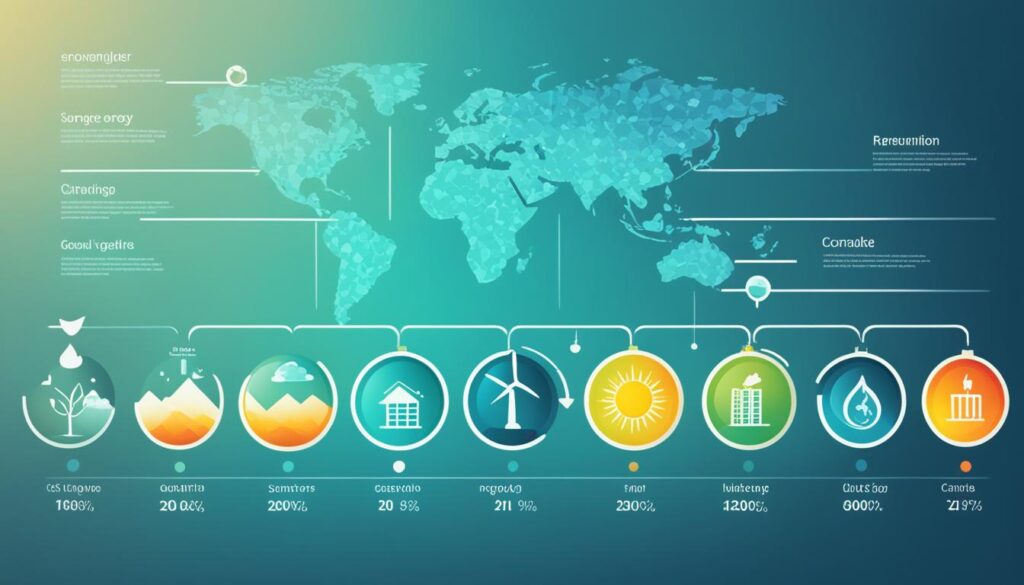Did you know that renewable energy now accounts for approximately one-third of global electricity generation? This remarkable statistic underscores a significant shift towards cleaner energy sources, essential for combating climate change. As over 75% of greenhouse gas emissions arise from energy production, transitioning to sustainable energy has never been more urgent. Experts agree that achieving net-zero emissions by 2050 is crucial for a habitable planet. They emphasize that enhanced efforts in renewable energy adoption are necessary to mitigate the impacts of climate change while catalyzing economic growth.
Key Takeaways
- Renewables currently provide about one-third of global electricity, highlighting a vital shift in energy production.
- Significant growth was seen in renewable generation capacity, with a record of 295 gigawatts added in 2022.
- Government subsidies play a crucial role in fostering renewable energy development.
- Maintaining a focus on cleaner energy sources is essential for reaching international climate goals.
- Public support for renewable energy initiatives is prominent, with a majority advocating for alternative energy development.
The Importance of Renewable Energy in Climate Change Mitigation
Renewable energy plays an essential role in climate change mitigation. As global awareness of the adverse effects of fossil fuel consumption grows, there is an urgent need to shift towards cleaner energy alternatives. Data indicates that over 75% of global greenhouse gas emissions are generated from fossil fuels. This alarming statistic necessitates immediate action to reduce these emissions significantly.
Wind and solar energy are at the forefront of this transition. The cost of generating electricity from wind has declined by 58% since 2009, while solar energy has seen an impressive drop of 78% during the same period. This significant cost reduction makes renewable energy sources more accessible to various populations. In the United States, renewable portfolio standards have saved consumers approximately $1.2 billion in reduced wholesale electricity prices in 2013, emphasizing the economic advantages of adopting renewable technologies.
Projections suggest that wind and solar capacity could double from 2015 levels by 2021. Additionally, some states have demonstrated remarkable progress. For instance, Iowa generates 31% of its total annual power from wind, and on several occasions, wind power supplied over 45% of Texas’s total energy demand. These advancements illustrate how adhering to renewable energy can substantially impact regional energy portfolios.
The global shift towards renewable sources is not just driven by environmental concerns but also by the health benefits associated with cleaner air. The renewable sector has supported nearly 200,000 jobs and provided $5.2 billion worth of health benefits through improved air quality. This human-centric approach aligns well with climate change mitigation strategies, as reducing greenhouse gas emissions contributes directly to better public health outcomes.
In summary, the transition to renewable energy offers a multifaceted solution to climate change mitigation. By embracing wind, solar, and other renewable sources, society can simultaneously address the urgent need to reduce greenhouse gas emissions while reaping economic and health benefits.

| Renewable Energy Source | Cost Reduction (%) | Capacity Contribution | Jobs Supported |
|---|---|---|---|
| Wind | 58 | Over 45% in Texas | Unknown |
| Solar | 78 | 4,300% increase in installed capacity (2007-2017) | Unknown |
| Geothermal | Unknown | Utilizes Earth’s internal heat | Unknown |
| Hydropower | Unknown | Largest renewable source globally | Unknown |
| Biomass Energy | Unknown | Contributes to energy mix | Unknown |
Current Landscape of Energy Production Globally
The world finds itself at a crucial juncture in global energy production. As of now, fossil fuels dominate the landscape, accounting for over 80% of total energy sources. Despite this massive reliance, promising trends indicate a transition towards renewable sources. In 2022, renewable energy contributed to an impressive 83% of new capacity additions, leaving fossil fuels and nuclear combined with just 17%. These energy statistics highlight a rapidly changing paradigm.

The necessity for change is underscored by urgent goals. The 1.5°C pathway demands a reduction of approximately 37 Gt in carbon dioxide emissions from 2022 levels and reaching net-zero emissions within the energy sector by 2050. Current projections reveal that, if left unchanged, emissions could reach 16 Gt by 2030, demonstrating a critical need for rapid adoption of renewable sources.
Investment trends further demonstrate the growing shift. In 2022, investments in renewable energy reached USD 0.5 trillion, a significant portion of the projected USD 150 trillion needed by 2050 to meet climate targets. With solar energy expected to generate more electricity than the entire U.S. power system by 2030, the emphasis on renewables will likely continue to accelerate.
Current policies and market demands may significantly alter the future of global energy production. The anticipated decrease in fossil fuels’ share—projected to drop to 73% by 2030—coupled with substantial investment shifts toward renewable technologies, creates an optimistic outlook for sustainable energy growth.
Despite the forward movement, challenges remain. The cumulative investments required to maintain the 1.5°C trajectory signify that substantial commitment from both public and private sectors is essential. The future landscape of energy hinges on embracing renewable sources while strategically reducing dependence on fossil fuels.
The Role of Sustainable Energy Sources in the Future
Sustainable energy sources play a crucial role in meeting future energy needs across the globe. With the renewable energy capacity projected to expand by 50% between 2019 and 2024, solar energy leads as a primary contributor. Currently, renewable resources account for 26% of the world’s electricity supply, a figure expected to reach 30% by 2024. This momentous growth illustrates a significant shift towards energy diversification, reducing the dependency on fossil fuels.
By 2024, the world’s solar capacity will increase remarkably, adding 600 gigawatts (GW) to the grid. This expansion is substantial, estimated to double the installed total electricity capacity of major energy-producing nations like Japan. In the United States, solar installations are expected to double, reaching four million by 2023. As countries like the UK and Australia continue to embrace solar technology, the global landscape of energy production becomes increasingly sustainable.
The affordability of solar power enhances its appeal. The cost of solar PV-based power dropped by 13% in 2018 and forecasts suggest an additional decline of 15%-35% by 2024. Increased installations in residential and commercial sectors are anticipated due to these lower prices. With predictions indicating that solar energy will comprise 60% of the anticipated renewable growth, investment in sustainable energy sources is vital for fostering economic development and ensuring energy security.

The importance of energy diversification becomes clear as the future unfolds. Predictions state that 72% of coal-based power may become unprofitable by 2040, signaling a transformative shift in market dynamics. With significant governmental backing, including over $150 billion allocated for clean energy projects in 2023, the pathway to a sustainable energy-focused future appears brighter. This investment and commitment highlight the need for continued focus on sustainable energy sources to secure energy needs for generations to come.
| Energy Source | Current Capacity (GW) | Projected Capacity by 2024 (GW) | Growth Rate (%) |
|---|---|---|---|
| Solar Energy | 300 | 600 | 100 |
| Onshore Wind | 541 | 850 | 57 |
| Offshore Wind | 22 | 65 | 195 |
| Hydropower | 1353 | 1474 | 9 |
| Geothermal | 14 | 18 | 29 |
Expert Opinion: The Future of Renewable Energy in a Changing World
Experts in the field are increasingly vocal about the accelerating energy transition, highlighting both the opportunities and obstacles associated with this shift. As renewable energy becomes more cost-effective and consumer demand for cleaner alternatives rises, the momentum for change is undeniable. An expert opinion stresses that overcoming various renewable energy challenges remains essential to unlocking the full potential of this transition. Furthermore, the experts emphasize the need for investment in infrastructure and technology to ensure a smooth and efficient transition to renewable energy sources. They also underscore the importance of addressing the ethical implications of genetic modification in the production of biofuels and other renewable energy sources. As the world moves towards a more sustainable energy future, it is crucial to consider the broader implications of these advancements on society and the environment.
Accelerating the Energy Transition
The landscape of energy production is evolving at an impressive pace. Currently, approximately 29% of the world’s electricity is sourced from renewables. This portion is expected to rise significantly. With the International Renewable Energy Agency (IRENA) predicting that up to 90% of global electricity could be generated from renewable sources by 2050, the focus on sustainable practices has intensified.
- The cost of electricity from solar power has diminished by 85% since 2010.
- Onshore and offshore wind energy costs have dropped by 56% and 48%, respectively.
- Renewables could provide 65% of global electricity by 2030.
- Decarbonization of the power sector may reach 90% by 2050.

Challenges Faced by Renewable Energy Adoption
The path to a clean energy future is not without its hurdles. Regulatory frameworks often lag behind innovations in renewable technologies. This lag can impede investment and slow down the expansion of necessary infrastructure. Fossil fuel dependency poses another significant challenge, as it represents over 75% of global greenhouse gas emissions and nearly 90% of carbon dioxide emissions.
| Challenge | Description |
|---|---|
| Regulatory Hurdles | Outdated regulations that fail to support new technologies can stall progress. |
| Infrastructure Needs | Current systems often require extensive upgrades to accommodate renewable sources. |
| Fossil Fuel Dependency | Heavy reliance on fossil fuels complicates the transition to cleaner options. |
A united effort is crucial to tackle these renewable energy challenges and harness the financial savings associated with clean energy. If executed properly, the shift could save the world an estimated $4.2 trillion annually by 2030 while creating upwards of 14 million new jobs in the clean energy sector.
Innovations in Clean Technology and Their Impact
Clean technology innovations are transforming the energy sector, particularly in solar energy developments and wind power. The advancements have led to higher efficiency and lower costs, making renewable energy solutions more competitive than ever. As countries strive for sustainable energy, integrating innovative technologies becomes essential for achieving long-term climate goals.
Emerging Technologies in Solar and Wind Energy
Recent breakthroughs in solar panels have seen efficiencies exceed 22%, a significant rise from around 15% a decade ago. Floating solar photovoltaic systems on water bodies are also gaining attention, benefiting from the cooling effect of water to increase performance. Offshore wind energy is not left behind; the UK’s Dogger Bank Wind Farm is emerging as the largest offshore wind project globally, underscoring the growing investment in wind energy. Innovations in ocean energy technologies aim to harness wave movements, predicted to contribute up to 10 percent of Europe’s electricity demand by 2050 while driving down costs.
Battery Storage and Energy Management Systems
Battery storage solutions and energy management systems are critical in stabilizing the grid as energy demands fluctuate. The European Union plans to install 40 GW of electrolysers by 2030 to facilitate green hydrogen production, representing a significant step in energy management advancements. Collaborative efforts among governments, researchers, and private sectors are driving these clean technology innovations, enhancing energy efficiency and creating new opportunities for sustainable energy deployment.

Renewable Energy Policies and Their Significance
Renewable energy policies play a crucial role in fostering the transition from conventional energy sources to cleaner alternatives. Effective energy regulations facilitate this shift by establishing frameworks that promote sustainable practices at various governmental levels. As nations strive to reduce greenhouse gas emissions, the policy impact becomes evident through various initiatives aimed at incentivizing investments in renewable technologies.
The U.S. has seen remarkable advancements driven by innovative policies. In 2023, a record 31 gigawatts (GW) of solar energy capacity was installed, marking a 55% increase from the previous year. This remarkable growth underscores the effectiveness of robust energy regulations that support solar projects. Additionally, states like Minnesota and Michigan adopted 100% clean electricity standards, showcasing ambitious climate action at the state level.
One key area where policy impact is significant is battery storage. Projections suggest that battery installations will double in 2024, securing greater energy storage capabilities to ensure a stable and resilient energy grid. Such initiatives directly align with the objectives of renewable energy policies that aim to bolster energy independence and create a sustainable energy future.

Table 1 below illustrates the effectiveness of various renewable energy policies across states, showcasing their influence on installed capacity and clean energy investments.
| State | Installed Solar Capacity (GW) | Clean Energy Standard Adoptions |
|---|---|---|
| California | 18.0 | 100% |
| Texas | 13.0 | 50% by 2030 |
| Florida | 6.0 | 30% by 2040 |
| Minnesota | 2.5 | 100% |
| Michigan | 3.0 | 100% |
Overall, the ongoing evolution of renewable energy policies not only accelerates the transition toward cleaner energy sources but also creates an environment conducive to innovation and investment in the renewable sector.
Economic Benefits of Transitioning to Renewable Sources
The shift to renewable energy presents not only an environmental imperative but also substantial economic benefits. The transition gears towards a more sustainable economy by fostering clean energy jobs and promoting cost-effective energy solutions that benefit consumers and communities alike. Understanding the comprehensive economic impacts underscores the urgency for this transition.
Job Creation in the Clean Energy Sector
Investing in renewable energy leads to significant job creation. The clean energy sector is exceeding expectations, with projections indicating that a move towards a 25-percent-by-2025 renewable energy standard could create approximately 200,000 jobs. This figure highlights a notable trend, as the clean energy industry generates more employment opportunities compared to fossil fuel sectors. For instance, in 2016, the wind and solar industries employed over 100,000 and 260,000 people respectively, showcasing a considerable increase in clean energy jobs over time.
Cost Comparison: Renewables vs. Fossil Fuels
When examining the economic benefits related to energy bills, a cost comparison between renewable sources and fossil fuels reveals that the former offers long-term savings for consumers. The costs associated with solar installations have decreased more than 70% from 2010 to 2017, while wind energy generation saw a 66% reduction in costs between 2009 and 2016. Such reductions not only make renewables more accessible but also help stabilize energy prices. This stability protects consumers from the volatility often observed in fossil fuel markets. Emphasizing renewables will ultimately lead to a more secure and predictable energy landscape.

The Fossil Fuel Phase-Out: What to Expect
The global move towards a fossil fuel phase-out reflects the urgent need for a sustainable energy future. Forecasts suggest a continual decline in reliance on fossil fuels, driven not only by environmental concerns but also by market demands and technological progress. The energy transition is not merely a process; it is becoming an unavoidable necessity as climate change intensifies. For instance, extreme weather events exacerbated by climate change caused colossal damages, with over $1 billion in losses for each of 15 such events in 2019 alone.
As renewable sources gain momentum, the implications for the future of fossil fuels become clearer. For example, last year, renewable energy outpaced coal in electricity generation within the United States. This shift aligns with American public sentiment, where 67% advocate for the advancement of alternative energy sources like wind, solar, and hydrogen technology. A substantial 31% are in favor of completely phasing out oil, coal, and natural gas. Despite this favorable outlook towards renewables, challenges abound. Some of the challenges include the intermittency of renewable energy sources, the need for infrastructure investment, and the potential displacement of workers in the fossil fuel industry. However, with continued innovation and investment, these challenges can be overcome, leading to a more sustainable energy future. Just as vince vaughn’s comedy career has faced ups and downs, the future of fossil fuels is also uncertain, but there is a growing consensus that renewable energy will play a pivotal role in shaping the energy landscape for years to come.
Transitioning from fossil fuels requires meticulous strategies and involvement from all stakeholders. Public opinion varies, highlighting differing perspectives on energy independence. While many believe a shift to renewable energy will facilitate energy independence, others express reluctance due to concerns such as rising consumer prices and job security. As the U.S. embarks on this journey, it is imperative to address these multifaceted issues to ensure a successful energy transition.

How the Green Economy is Reshaping Industries
The green economy is revolutionizing various industries by prioritizing sustainability and environmental stewardship. Clean energy investments are at the forefront of this transformation, driving significant changes across multiple sectors. As more than 100 countries set renewable energy targets, the emphasis on clean energy creates a ripple effect, promoting economic growth and community benefits.
Investments in Clean Energy and Infrastructure
Investment in clean energy has surged significantly, increasing by 40% since 2020 according to the International Energy Agency. This financial commitment not only supports renewable energy generation but also facilitates the development of necessary infrastructure. The global renewable energy market is projected to reach $1,977.6 billion by 2030, with solar and wind power anticipated to lead in capacity growth. The shift towards a green economy is expected to create approximately 25 million jobs by 2030, highlighting the importance of this sector for economic stability and job creation.
Community Benefits from Renewable Energy Projects
Renewable energy projects offer immense community benefits, especially in terms of job opportunities and environmental improvement. The passage of the Inflation Reduction Act in the U.S. anticipates creating over 1.5 million new jobs within ten years. Furthermore, green jobs are among the fastest-growing occupations, particularly in energy efficiency and innovative renewable technologies. Employment growth in these sectors contributes to enhanced local economies and fosters a sense of resilience among communities.
Investments in renewable energy directly impact quality of life by improving air quality, reducing greenhouse gas emissions, and promoting sustainable practices. As more communities engage in clean energy initiatives, the positive effects multiply, reinforcing the significance of the green economy.

| Key Statistics | 2022 Figures | Projected Growth |
|---|---|---|
| Direct and Indirect Renewable Energy Jobs | 13.7 million | Growing to 25 million by 2030 |
| Solar Photovoltaic Jobs | 4.9 million | Leading sector for job creation |
| Jobs Created Post-Inflation Reduction Act | Over 100,000 | 1.5 million within a decade |
| Global Renewable Energy Market Value | $1,977.6 billion | By 2030 |
Conclusion
As the world strides towards a more sustainable future, the dynamics of energy production and consumption are transforming. The future of renewable energy looks promising, bolstered by expert insights and innovations in clean technology that advocate for a swift renewable energy transition. With nearly 25 gigawatts of coal plants anticipated to retire, there is a substantial shift underway towards greener alternatives. Notably, studies indicate that up to 80% of U.S. electricity could be derived from renewable sources by 2050, spotlighting the significant potential for climate action in mitigating environmental impacts.
In this context, the decreasing costs associated with solar and wind energy—having dropped by 70% and 89% respectively over the past decade—reinforce the competitiveness and accessibility of these resources compared to traditional fossil fuels. Furthermore, as electric vehicle adoption continues to surge, with projections suggesting that 86% of vehicles could be electric by 2050, the need for a robust and smart energy infrastructure becomes paramount. This transition isn’t merely beneficial; it represents an essential pathway towards achieving national climate objectives while fostering job creation and economic growth.
With ongoing technological advancements and legislative support, the imperative for regulatory frameworks that encourage energy efficiency and renewable energy implementation cannot be overstated. As communities rally behind renewable energy projects, it becomes increasingly clear: action taken today will forge a resilient, sustainable tomorrow. The collective commitment to climate action ensures the advancement of the renewable energy sector, with every step taken paving the way not only for a cleaner environment but also for a thriving green economy.










